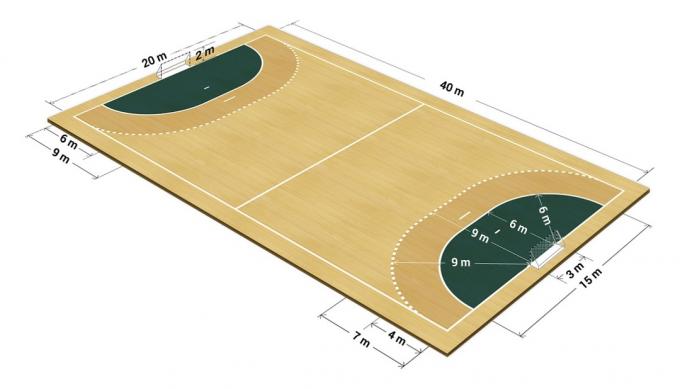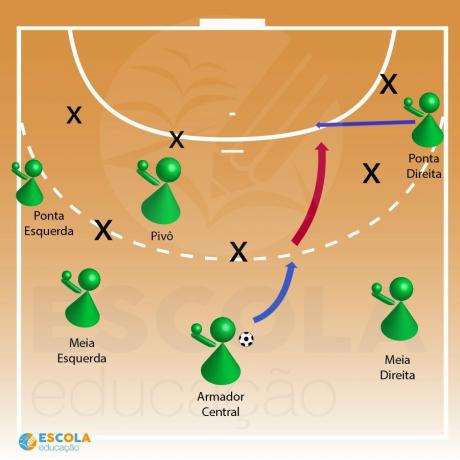Created in Germany in 1919, handball, also known as handball, is a sport where two teams face the goal of scoring goals by throwing the ball with your hands.
Many countries have high-performance men's and women's teams that, throughout the year, participate in tournaments and championships.
In Brazil, despite the sport being less widespread than soccer and volleyball, teams always stand out in national and world tournaments, thus guaranteeing several medals.
Index
- Origin, history and consolidation of handball
- Fundamentals and Structure of a Handball Match
- handball rules
- Handball Positions
- How cards work in handball
Origin, history and consolidation of handball

The German Karl Schelenz (1890-1956) was an athlete and physical education teacher, responsible for the creation of handball in 1919. After about 100 years, the sport underwent some changes, until it established itself as we know it today.
Despite being a German sport, its name comes from the English language. The meaning of hand in the language is “hand”.
Initially created to be a women's sport, the matches were played outdoors, on smaller fields and lawns. The first matches of the modality were held in Berlin, in the post-World War I period.
Its spread around the world was fast, also including men's teams. In 1930, handball became part of the Berlin Olympic Games. Until that moment, it was played the way it was conceived, that is, with a total of 22 players, 11 on each side.
From 1972, with fewer players, seven per team and played on a larger field, the sport was reintroduced in the Olympic Games after some time out.
From that time until today, the sport has reached many nations. In 1999 the International Handball Federation, based in Switzerland, was created.
Currently, the World Handball Championship is held every two years. The European teams continue as the biggest highlights in the world. The men's team in France, for example, is a six-time champion.
Brazil was crowned women's world champion in 2013, but the sport is still not very representative in the country, having the biggest teams in Rio de Janeiro, São Paulo, Paraná and Minas Gerais.
Fundamentals and Structure of a Handball Match
Check what are the specifications established in relation to the teams, ball and to court shape.

- The object of the game is to score goals. For this, players use throws, dribbles, passes and catches.
- Matches are played by two teams, each with seven players. One of them will be the goalkeeper while the others remain on the field.
Handball Ball
- Free Online Inclusive Education Course
- Free Online Toy Library and Learning Course
- Free Online Math Games Course in Early Childhood Education
- Free Online Pedagogical Cultural Workshops Course
- For men's teams, the handball, which is made of leather or similar synthetic material, has a circumference of 58.4 cm and a weight of 453.6 grams.
- For females, the circumference is 56.4 cm, while the weight is 368.5 grams;
Handball Court
- The handball court has the following dimensions: 40 meters long by 20 meters wide. At each end there is a goal, measuring 2×3 meters. The floor can be rubberized or varnished wood;
- The court will be delimited by the sidelines and end lines. There are also lines of 4, 6, 7 and 9 meters.
- 4-meter line: serves to limit the goalkeeper when taking a 7-meter shot;
- 6 meter line: delimits the goalkeeper's area;
- 7-meter line: establishes the positioning for the 7-meter throw;
- 9 meter line: specific for free kicking, it is where the defensive barrier will be formed.
handball rules
As in other sports, handball players are subject to a series of rules during the match. See what are the main rules:
- A match lasts 60 minutes and is divided equally into two 30-minute halves. In case of a tie, the game is extended by two more periods, of 5 minutes each;
- Between each of the times there is an interval of 10 minutes;
- All games are supervised by two referees and a timekeeper;
- While in possession of the ball, the player can take up to three steps without passing it forward;
- However, if he is bouncing the ball he can take more steps, but in these cases the chances of the opponent taking possession of the ball increase;
- At each play, the player can remain with the ball in hand for only 3 seconds;
- Speaking of which, the ball, under no circumstances can be taken from the opponent's hands;
- According to the rules, it is only possible to take the ball using a single open hand;
- Players cannot remain in the goalkeeper's area;
- It is allowed to block a player with his own body, however, the use of any type of physical aggression, such as elbows, jerks and shoves and kicks, under penalty of punishment with yellow cards or Red.
Handball Positions

The positions of players in a handball game are as follows:
- Goalkeeper – He is the one who defends the goal with almost every part of his body. He is the only player who can touch the ball with his feet.
- pivot – He is the strength of the game where he hinders rivals while defending. He's fast and works to increase his teammates' chances to score.
- Shipowner – He is a creative player who used to direct the play both in defense and attack. You should always pay attention to the game, building strategies during the game. This position requires a lot of concentration and vision of the game.
- Tips – Fast players guard the sides of the handball court. They usually shoot from the toughest angles and used to create large openings making the game easier for their teammates.
- Socks – They are usually the biggest players on the team. While defending, they try to block attacks. They are also the athletes who shoot the furthest in the handball game.
They exist 7 reservations on each handball team, but they cannot play until the player on the field is out of bounds. Substitution is allowed at any time, with no limits.
How cards work in handball
As in football, during handball matches, candidates can be punished by means of red and yellow cards given by the referee.
In this sport, fouls are recorded when the ball touches the feet or other parts of the body, when a player has to snatch the ball from the hands of another, or when there are physical aggressions between the players.
An interesting curiosity is that the only players who can touch the ball with their feet, without a free kick, are the goalkeepers.
In cases of lighter fouls, they are punished by arbitration by means of a yellow card. However, during a match a player can only receive three yellow cards. In the second consecutive he is punished with two minutes out of the match, in the third he is automatically eliminated from the game.
When more serious faults are registered, the referees use the red card. Thus, the player is immediately expelled from the game. As a penalty, your team will have to spend two minutes with one player less on the field. After this time, it can be replaced.
Get to know details of other sports:
- Basketball
- Fencing
- Baseball
- futsal
- Badminton
- Athletics
- Volleyball
The password has been sent to your email.

